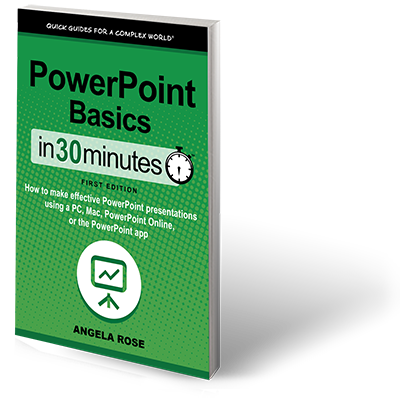When you think about communicating ideas and information to a group of people in a room or venue, it’s easy to understand why so many people choose PowerPoint for their presentations. In fact, according to the Social Science Research Network, visual learners, or people who need to see what they are learning in order to understand and absorb it, make up 65 percent of the population.
I began to use PowerPoint more than a decade ago, while working as a creative department manager at a small marketing company. Our clients, who were primarily mortgage and real estate agents, wanted an effective way to educate their customers on various homeownership topics. We began to design customizable PowerPoint presentations on exciting subjects such as the mortgage application process, fixed-rate versus adjustable rate loans, and real estate taxes.
There are many more possibilities for using PowerPoint. Over the years, I’ve encountered the following types of presentations, both in person and online:
- University lectures
- Doctors’ salaries
- Pharmaceutical research methods
- Early Edwardian fashion
- The health benefits of turmeric
- The history of the soufflé
- How to irrigate your sinuses
However, as a crazy cat lady in training, my favorite PowerPoint presentations of late are those created by a feline rescue organization in Canada. Configured to autoplay and be shared online, the presentations focus on spaying and neutering, as well as the value of feral and formerly feral felines. While the presentations range from amusing to moving, they are always informative and memorable—as every truly great PowerPoint must be.
A versatile visual tool
As I mentioned earlier, it has been estimated that people around the world create tens of millions of PowerPoint presentations every day. Because it’s such a versatile visual communication tool, people find all kinds of uses for the software. Here are just a few examples:
- Oscar has a great idea for a new company and needs to pitch it to investors. It has been a few years since he last worked with PowerPoint, so he purchased this book to help him create a presentation to illustrate his business plan which he can use in meetings to engage bankers or potential investors.
- Martha is the manager of a growing dental office. She recently realized she needs a bigger budget for office supplies. She is using a PowerPoint presentation to outline the areas in which her current budget is falling short, as well as show how a greater investment in these resources will improve staff productivity.
- Norbert is a high school history teacher and uses PowerPoint in his classroom. Familiar with the numerous studies on visual learning, he creates presentations that review essential information before final exams. (Because he often goes six months or more between presentations, he refers to this book whenever he needs to refresh his knowledge of the software’s basic features.)
- Robin loves cats and has taken it upon herself to care for a colony of strays in her neighborhood. Unfortunately, the local homeowners’ association wants to trap and destroy them. She is using PowerPoint to create a compelling presentation about trap, neuter and release programs that she can share at the next association meeting. This book will help her avoid common pitfalls that could reduce the effectiveness of her slide deck.
- Barbara is a scientist who works for the U.S. Centers for Disease Control and Prevention (CDC). Her assistant, who usually puts together the department’s research summaries, is on family leave. Because the budget won’t support hiring a temporary replacement, Barbara plans to use PowerPoint on her own to share research updates with upper management.
- Jordan is a computer-savvy 9-year-old and he really, really, really wants a dog. When regular whining didn’t work, he decided to put together a PowerPoint presentation to teach his parents about all the reasons why he should have a dog and what he’ll do to help take care of it if he gets a puppy for his birthday.
PowerPoint can be a complex software application. We won’t be getting into all of the tools and advanced features. However, if you’re a novice user or just want a quick refresher, then you will find lots to love in this guide. It contains plenty of step-by-step instructions and screenshots to get you going, as well as protips and best practices to nudge you toward the next level. Topics include:
- Navigating PowerPoint’s Ribbon.
- How to create a new presentation.
- Adding, copying, and reordering slides.
- Formatting text, backgrounds, and more.
- Adding cool effects such as transitions and animations.
- How to save, print, export, and present PowerPoint slide decks.
You’ll learn all of this in about 30 minutes. That’s less time than it takes to watch a TV sitcom. If you’re ready, let’s get started!
